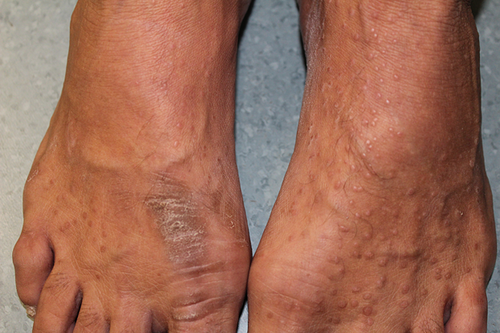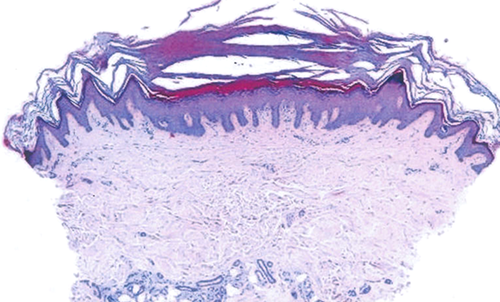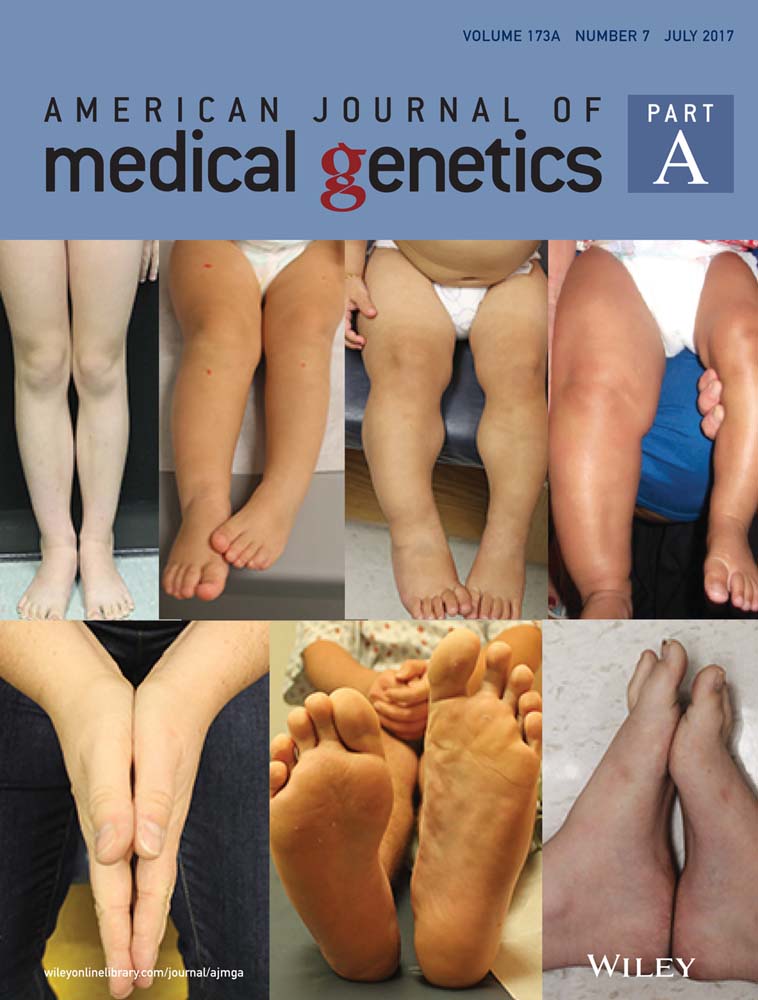Recurrent ATP2A2 p.(Pro602Leu) mutation differentiates Acrokeratosis verruciformis of Hopf from the allelic condition Darier disease
Abstract
Darier disease and Acrokeratosis Verruciformis of Hopf (AKV) are rare disorders of keratinization with autosomal dominant inheritance and very distinct clinical pictures. Both have been shown to be caused by mutations in ATP2A2 (ATPase, Ca++ transporting, cardiac muscle, slow-twitch) a gene encoding one of the SERCA (sarcoplasmic/endoplasmic reticulum calcium ATPase2) intracellular pumps with a crucial role in cell-to-cell adhesion in both skin and heart. While hundreds of different missense and nonsense mutations cause Darier disease, only one missense mutation, p.(Pro602Leu), has been identified in families with AKV. We report a family with AKV due to the p.(Pro602Leu) mutation and discuss implications for this recurrent mutation on knowledge of ATP2A2 structure and function.
1 INTRODUCTION
Darier disease and Acrokeratosis Verruciformis of Hopf (AKV) are rare genodermatoses which share features of hyperkeratosis and autosomal dominant inheritance. Darier disease is a severe generalized and debilitating disorder causing widespread greasy and malodorous warty plaques on the skin with flexural predominance. Acantholysis is a characteristic histological feature, reflected in skin and mucosal fragility. Reported associations include corneal damage and increased frequency of neuropsychiatric disorders. AKV is mild, limited to keratotic papules on the dorsum of the hands and feet in most with nail and palmar involvement in some. Both conditions show completely penetrant expression in adults.
Despite decades of suspicion that these are related disorders they remain clinically distinct and in only rare exceptions have been found to co-exist in families. Acral papules may be an early manifestation in Darier disease however making this distinction difficult in childhood and sporadic cases (Dhitavat et al., 2003). Many families have a “pure” AKV phenotype with no progression to Darier disease seen in many generations. The finding of causative mutations in the ATP2A2 gene first in Darier disease (Sakuntabhai et al., 1999) and shortly after in AKV (Dhitavat et al., 2003) proved that these are allelic disorders. Mutation analysis of 2 large affected pedigrees with “pure” AKV, one British and one Druze, identified the same ATP2A2 p.(Pro602Leu) mutation in each (Bergman, Sezin, Indelman, Helou, & Avitan-Hersh, 2012; Dhitavat et al., 2003). A de novo p.(Ala698Val) variant in ATP2A2 was reported in a simplex case of an 11 year old Afghani boy with no family history of AKV, but given his age and the lack of other affected relatives it remains to be proven that this was not early manifestation of Darier Disease (Bergman et al., 2012; Berk, Taube, Bruckner, & Lane, 2010; Dhitavat et al., 2003). One study of two Chinese families with AKV did not identify any mutation in ATP2A2 (Wang et al., 2006).
Recently a database of ATP2A2 variants has been created using The Leiden Open Variation Database (LOVD) (Nellen et al., 2017). LOVD currently lists 277 unique ATP2A2 mutations in 506 individuals. Mutations associated with Darier disease are distributed throughout the gene and mostly unique to one affected family. One sporadic individual with a phenotype previously described as Darier disease is listed here as “AKV with Guttate Leucoderma” (Nellen, Arits, van Geel, Steijlen, & van Steensel, 2015). Four families with AKV are included, two previously reported and two new, and all have the same ATP2A2 p.(Pro602Leu) variant (Bergman et al., 2012; Dhitavat et al., 2003; Nellen et al., 2017). The p.(Pro602Leu) variant was not seen in any families with a classic Darier disease phenotype (Nellen et al., 2017).
We have identified the recurrent ATP2A2 p.(Pro602Leu) mutation in a large Australian family with AKV. This means that the only five AKV-affected families known to have a genetic diagnosis carry the same missense mutation in the ATP-binding domain of the ATP2A2 gene. ATP2A2 is central to calcium transport involved in desmosomal cell-to-cell signaling and adhesion, not only in skin but also cardiac myocytes, significant in both causation and treatment options for heart failure (Prasad et al., 2015). We reframe the question around Darier disease and AKV from Are they the same? to Why are they different? and suggest avenues of further research to clarify the function of ATP2A2 as it affects cellular adhesion.
2 MATERIALS AND METHODS
A 53-year-old Australian woman of English and possibly Portuguese descent was referred to the cardiac genetic service in Newcastle NSW for investigation of Long QT syndrome. It was noticed that she had multiple skin-colored keratotic lesions over the dorsum of both hands and feet with longitudinally ridged, brittle fingernails (Figure 1). The skin lesions had been present from childhood and responded partially to topical salicylic acid applications but were not a major problem for her. Palmar skin was thickened and dry which she related to occupational use of cleaning fluids. There were also small keratotic patches of skin on the medial knees and thighs. Two years previously she had undergone a partially successful corneal transplant for unilateral corneal keratosis secondary to keratoconus. Between the ages of 1 and 4 years she had recurrent short seizures which were not all related to known fevers. She had no current neurological or psychiatric problems.

Other family members including mother, maternal aunts, two brothers, nephew, and niece were reported to have identical lesions on the dorsum of the hands, with only her mother also having nail involvement. No other relatives had corneal keratosis requiring treatment. No family member for at least four generations was known to have had more widespread disease or features resembling Darier disease. There were no significant neuropsychiatric disorders in the affected family members. Two adult brothers with AKV had childhood febrile convulsions but no seizures since then.
3 RESULTS
Dermatological review suggested the diagnosis of Acrokeratosis verruciformis of Hopf (AKV) and two punch biopsies were taken from one hand and one foot. Histopathology showed hyperkeratosis, “church-spire” papillomatosis, hypergranulosis, and moderate acanthosis diagnostic of AKV (Figure 2). There was no evidence of acantholysis suggestive of Darier disease.

Sequencing of the ATP2A2 gene including coding regions of all transcripts of the gene and their flanking regions (approximately 20 bp from each side) performed by Gene by Gene Laboratories (Houston, Texas) identified a heterozygous p.(Pro602Leu) missense mutation in exon 14. This mutation has previously been shown to lead to complete loss of calcium transport activity (Dhitavat et al., 2003).
No genetic cause for Long QT syndrome was identified. In light of the known association between keratinizing dermatoses and Arrhythmogenic Right Ventricular Cardiomyopathy an echocardiogram was performed which was normal.
4 DISCUSSION
This report describes the fifth family with a “pure” AKV phenotype for whom a genetic diagnosis has been made. All five families have the recurrent p.(Pro602Leu) missense mutation causing loss of function of the ATP2A2 gene, and this variant has not been reported in any individual with classic Darier disease. In keeping with the purely AKV phenotype seen with this variant, our family had no features of Darier disease in four generations. Our patient also suffered significant corneal keratosis which has been reported in Darier disease (Blackman, Rodrigues, & Peck, 1980). However this was clearly linked to a co-existing ophthalmological diagnosis of bilateral keratoconus.
The ATP2A2 gene is one of a family of genes encoding ATP-coupled calcium ion pumps situated in the sarcoplasmic/endoplasmic reticulum membrane (SERCAs). Their action is to actively transport Ca(2 +) into the sarcoplasmic reticulum, believed to play a key role in the signaling pathway regulating cell-to-cell adhesion and differentiation of the epidermis (Sakuntabhai et al., 1999), but also in protecting cardiac muscle from failure, particularly under load stress (Prasad et al., 2015; Savignac, Simon, Edir, Guibbal, & Hovnanian, 2014). Four specific SERCA2 isoforms result from alternate splicing, with isoform 2b expressed particularly in keratinocytes, and isoforms 2a and 2c in heart muscle. SERCA2 has a large intramembranous domain while the “ATP-binding” domain crucial to activation of Ca(2 +) transport is located in the cytosol. The p.(Pro602Leu) substitution found in AKV families lies in this ATP-binding domain.
Pathogenic ATP2A2 variants in Darier disease include non-sense and missense mutations both affecting the ATP-binding domain and spread throughout the gene. At least 75% are “private” or unique to the family affected, with some others reported in two to four families (Green et al., 2013) and many are de novo. Attempts at genotype-phenotype correlation have been unsuccessful, with attempts to associate neuropsychiatric complications with 3′ missense mutations (Jacobsen et al., 1999) being refuted by more recent comprehensive reviews (Nellen et al., 2017). Some families have been reported to have a “mixed” phenotype of AKV and Darier disease in various members, and in these families ATP2A2 variants have been identified which lie outside the ATP-binding domain (Nellen et al., 2017).
However the distinctive clinical picture of AKV as evidenced by non-progression to Darier disease over many generations appears to be associated only with one mutation, p.(Pro602Leu), located in the ATP-binding domain. Review of both literature and online mutation databases did not identify any case of Darier disease caused by the p.(Pro602Leu) mutation.
Functional studies to date suggest haploinsufficiency of ATP2A2 as the basis for both Darier disease and AKV, with decreased Ca(2 +) transport, binding or feedback sensitivity in most mutants including p.(Pro602Leu) (Dhitavat et al., 2003; Nellen et al., 2017). However one study, which did not include the p.(Pro602Leu) variant, identified that mutant SERCA2 inhibited wild-type protein activity, possibly through formation of less active heterodimers, suggesting a possible ‘dominant negative’ effect (Ahn, Lee, Kim, & Muallem, 2003).
Distinct diseases caused by variants in the same gene, known as ‘allelic disorders’ are well recognized. Mechanisms for the differing phenotypes may be evident from examination of the variants involved or functional studies. Thus Kennedy disease is caused by a CAG triplet repeat expansion and Androgen Insensitivity syndrome by point mutations in the same gene SMAX1. In the more similar GJB2-associated disorders KID and Vohwinkel syndromes, difference in severity may be due to truncating mutations in the former and missense in the latter condition. Gain and loss of function variants in SCN5A cause Long QT syndrome and Brugada syndrome respectively. Alteration of a specific functional domain or binding site may lead to distinct phenotypes as seen in the spectrum of RET gene mutations, with those causing enhanced dimerization associated with Multiple Endocrine Neoplasia (MEN) type 2A, altered substrate specificity leading to MEN type 2B, and others causing Hirschprung disease. Much can be learned about the function of a gene by observation of these disparities, whether they are seen as “allelic disorders” or “genotype-phenotype correlations.”
It is quite unique however that one recurrent missense mutation causes a distinct inherited phenotype, as in the ATP2A2 p.(Pro602Leu) variant causing AKV, with a different disorder, Darier disease also caused by missense mutations including those in the same functional domain of the gene in close proximity to p.(Pro602Leu). AKV is obviously related to Darier disease in pathology, but does not show the characteristic acantholysis in the suprabasal layer of the epidermis causing skin fragility in Darier disease, and remains a mild skin disorder limited to the extremities. Extensive inter- and intrafamilial variation is seen in Darier Disease, but not in AKV. Stress caused by emotion, heat, mechanical stress and UV radiation is known to worsen Darier disease while AKV is relatively stable and non-progressive. They are very distinct conditions, to the extent that AKV has probably avoided diagnosis and research attention due to its very mild presentation.
Functional studies to date do not provide the cause of this phenotypic distinction. Missense mutations at the ATP binding domain are involved in both conditions. Although p.(Pro602Leu) occurs at a highly conserved site in all human SERCA1, 2 and three isoforms, loss of Ca(2 +) transport has been demonstrated with other ATP-binding site mutations as well as this variant (Dhitavat et al., 2003; Nellen et al., 2017). It is not obvious that the AKV-associated p.(Pro602Leu) mutation should have a significantly different effect on known binding sites than the adjacent p.(Arg603Ile) mutation identified in a family with Darier disease. It is still possible that a dominant-negative effect of mutant SERCA2 protein associated with Darier disease is somehow avoided with the p.(Pro602Leu) variant as this has not been studied. Cell-to-cell adhesion is more severely and widely affected in Darier disease than AKV, where upregulation of keratinocyte differentiation rather than acantholysis may be the only response to local stress and skin trauma. The specific consequences of missense variants on calcium homeostasis at intracellular versus endoplasmic reticulum level and the flow-on effects to desmosome and cell adherence have been studied for many mutations, but not specifically the p.(Pro602Leu) variant to our knowledge. It may be at this cellular level where the difference is crucial. Expression of SERCA2 in basal, suprabasal and acantholytic epidermal keratinocytes was reported to be increased in cultured Darier disease cells compared to normal cells, (Sheridan et al., 2002), but again this association has not been tested with the specific p.(Pro602Leu) variant seen in familial AKV.
This question may not just be of interest to dermatologists. The desmosome and the mechanisms of cell-to-cell adhesion are critical in maintenance of myocardial contractility and strength. Calcium channel and desmosomal gene mutations cause Arrhythmogenic Right Ventricular Cardiomyopathy (ARVC) (Tiso et al., 2001). While ATP2A2 has not been associated with ARVC it is known to play a key role in Ca(2 +) homeostasis in the heart and inhibition is associated with decreased contractility and heart failure (Prasad et al., 2015).
Discussion has long centered around whether AKV and Darier disease are truly “allelic disorders.” There can be no doubt now that they are closely related through their proven associations with the ATP2A2 gene. We propose that there is enough evidence through these AKV families to direct future functional studies in this area to comparison of consequences of the p.(Pro602Leu) variant on calcium homeostasis and cell signaling/ adhesion with those variants causing Darier disease. This highly specific genotype-phenotype relationship could reveal much of clinical importance about maintenance of the desmosome.
ACKNOWLEDGMENT
We are grateful to our patient for giving permission to publish her details in the interest of sharing knowledge.
CONFLICT OF INTEREST
None.




